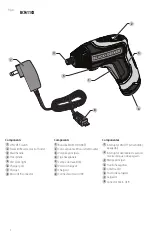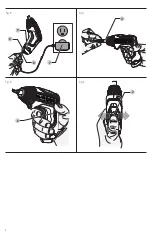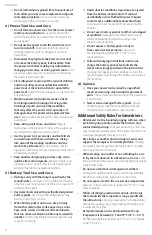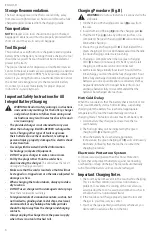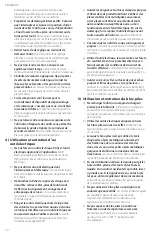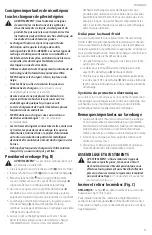
5
English
READ ALL INSTRUCTIONS
Important Safety Instructions for All
Integral Battery Tools
WARNING:
Read all safety warnings, instructions,
and cautionary markings for the battery, USB
cable and product. Failure to follow the warnings
and instructions may result in electric shock, fire
and/or serious injury.
•
NEVER force a charger cord plug into the tool.
•
DO NOT modify a charger cord plug in any way to fit
into the tool as the battery may rupture causing serious
personal injury.
•
DO NOT charge or use the battery in explosive
atmospheres, such as in the presence of flammable
liquids, gases or dust.
Inserting or removing the USB
cable plug from the tool may ignite the dust or fumes.
•
DO NOT
splash or immerse in water or other liquids.
•
DO NOT
allow water or any liquid to enter tool.
•
DO NOT store or use the tool in locations where the
temperature may reach or exceed 104 °F (40 °C) (such
as outside sheds or metal buildings in summer).
For
best life store tools in a cool, dry location.
NOTE: Do not store the tool with the switch locked on.
Never tape the switch in the ON position.
•
DO NOT incinerate the tool even if it is severely
damaged or is completely worn out.
The battery can
explode in a fire. Toxic fumes and materials are created
when lithium‑ion batteries are burned.
•
If battery contents come into contact with the skin,
immediately wash area with mild soap and water.
If
battery liquid gets into the eye, rinse water over the open
eye for 15 minutes or until irritation ceases. If medical
attention is needed, the battery electrolyte is composed of a
mixture of liquid organic carbonates and lithium salts.
•
Contents of opened battery cells may cause
respiratory irritation.
Provide fresh air. If symptoms
persist, seek medical attention.
•
Battery liquid may be flammable if exposed to spark
or flame.
•
Never attempt to open the tool for any reason. If the
tool case is cracked or damaged, do not charge.
Do
not crush, drop or damage the tool. Do not use a tool or
charger that has received a sharp blow, been dropped, run
over or damaged in any way (e.g., pierced with a nail, hit
with a hammer, stepped on). Damaged tools should be
returned to the service center for recycling.
BATTERY AND CHARGER
The battery is not fully charged out of the carton. Before using
the charger to charge the battery, read the safety instructions
below and then follow charging procedures outlined.
n
..................... avoid staring at
light
l
or AC............alternating current
Ah ....................... amp hours
The label on your tool may include the following symbols. The
symbols and their definitions are as follows:
BPM ....................beats per minute
V ......................... volts
min .....................minutes
j
or DC ............direct current
…/min ..............per minute
RPM .................... revolutions per
minute
A .........................amperes
Hz .......................hertz
W ........................watts
Wh ......................watt hours
no .......................no load speed
n .........................rated speed
c
.....................safety alert symbol
h
..................... wear respiratory
protection
f
..................... wear eye protection
i
..................... Class II Construction
(double insulated)
g
..................... wear hearing
protection
a
..................... read all
documentation
Additional Safety Information
WARNING:
Never modify the power tool or any part of
it. Damage or personal injury could result.
WARNING: ALWAYS
use safety glasses. Everyday
eyeglasses are NOT safety glasses. Also use face or
dust mask if cutting operation is dusty. ALWAYS WEAR
CERTIFIED SAFETY EQUIPMENT:
• ANSI Z87.1 eye protection (CAN/CSA Z94.3),
• ANSI S12.6 (S3.19) hearing protection,
• NIOSH/OSHA/MSHA respiratory protection.
WARNING:
Some dust created by power sanding,
sawing, grinding, drilling, and other construction activities
contains chemicals known to the State of California to
cause cancer, birth defects or other reproductive harm.
Some examples of these chemicals are:
• lead from lead‑based paints,
• crystalline silica from bricks and cement and other
masonry products, and
• arsenic and chromium from
chemically‑treated lumber.
Your risk from these exposures varies, depending on
how often you do this type of work. To reduce your
exposure to these chemicals: work in a well ventilated
area, and work with approved safety equipment, such
as those dust masks that are specially designed to filter
out microscopic particles.
•
Wear protective clothing and wash exposed areas
with soap and water.
Allowing dust to get into your
mouth, eyes, or lay on the skin may promote absorption of
harmful chemicals. Direct particles away from face and body.
•
Use the appropriate dust extractor vacuum to remove
the vast majority of static and airborne dust
. Failure
to remove static and airborne dust could contaminate the
working environment or pose an increased health risk to
the operator and those in close proximity.
•
Use clamps or other practical ways to secure and
support the workpiece to a stable platform.
Holding
the work by hand or against your body is unstable and may
lead to loss of control and injury.
•
Air vents often cover moving parts and should be
avoided.
Loose clothes, jewelry or long hair can be caught
in moving parts.
Summary of Contents for BCF611CB
Page 4: ...2 Fig B Fig C Fig D Fig E 7 4 2 6 3 8 9 ...
Page 25: ...23 ...
Page 26: ...24 ...
Page 27: ...25 ...
Page 28: ...07 20 Part No N748171 Black Decker U S Inc 701 East Joppa Road Towson MD 21286 Copyright 2020 ...



